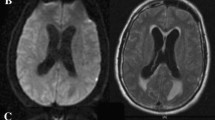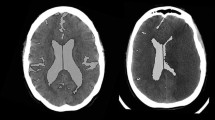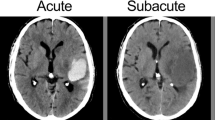Abstract
Background
Global cerebral edema (GCE) is a manifestation of early brain injury (EBI) after subarachnoid hemorrhage (SAH) and is an independent risk factor for poor outcome. The lack of a quantitative method to measure GCE limits the study of its pathophysiology. The goal of this study is to develop a quantitative surrogate marker that represents GCE after SAH.
Methods
Patients with spontaneous SAH were enrolled into a prospective observational database. Initial CT scans were graded for GCE using established qualitative criteria. Selective sulcal volume (SSV) was defined as total mL of sulcal volumes on axial CT slices above the most cranial section of the lateral ventricles to the last visible section. Using a semiautomatic threshold approach, sulcal regions were traced out with manual adjustments when necessary. The volume of sulci in each slice was calculated and multiplied by the slice thickness and number of slices to calculate the SSV. All volumetric analysis was performed using Medical Image Processing, Analysis and Visualization Version 7.0.1 (MIPAV).
Results
A total of 109 subjects were included in our analysis. Mean selective sulcal volumes (SSV) differed between subjects with and without GCE 4.5 and 21.2 mL (P < 0.001). When separated into quartiles, the odds of qualitative GCE increases as SSV decreases. Compared to the highest SSV quartile, smaller SSV was associated with worse clinical outcomes.
Conclusion
GCE can be quantified using volumetric analysis of SSV measurements on routine CT scans. Smaller SSV on admission is predictive of worse clinical outcomes. SSV may be an important marker of EBI after SAH.



Similar content being viewed by others
References
Bederson JB, Connolly ES Jr, Batjer HH, et al. Guidelines for the management of aneurysmal subarachnoid hemorrhage: a statement for healthcare professionals from a special writing group of the Stroke Council, American Heart Association. Stroke. 2009;40:994–1025.
Broderick JP, Brott TG, Duldner JE, Tomsick T, Leach A. Initial and recurrent bleeding are the major causes of death following subarachnoid hemorrhage. Stroke. 1994;25:1342–7.
Cahill WJ, Calvert JH, Zhang JH. Mechanisms of early brain injury after subarachnoid hemorrhage. J Cereb Blood Flow Metab. 2006;26:1341–53.
Chen S, Feng H, Sherchan P, et al. Controversies and evolving new mechanisms in subarachnoid hemorrhage. Prog Neurobiol. 2014;115:64–91.
Sabri M, Lass E, Macdonald RL. Early brain injury: a common mechanism in subarachnoid hemorrhage and global cerebral ischemia. Stroke Res Treat. 2013;2013:394036.
Sehba FA, Pluta RM, Zhang JH. Metamorphosis of subarachnoid hemorrhage research: from delayed vasospasm to early brain injury. Mol Neurobiol. 2011;43:27–40.
Claassen J, Carhuapoma JR, Kreiter KT, Du EY, Connolly ES, Mayer SA. Global cerebral edema after subarachnoid hemorrhage: frequency, predictors, and impact on outcome. Stroke. 2002;33:1225–32.
Helbok R, Claassen J. Global cerebral edema and brain metabolism after subarachnoid hemorrhage. Crit Care. 2011;15:1–190.
Kassell NF, Torner JC, Haley EC Jr, Jane JA, Adams HP, Kongable GL. The international cooperative study on the timing of aneurysm surgery: part 1: overall management results. J Neurosurg. 1990;73:18–36.
Bazin P, Cuzzocreo JL, Yassa MA, et al. Volumetric neuroimage analysis extensions for the MIPAV software package. J Neurosci Methods. 2007;165:111–21.
Ko SB, Choi HA, Carpenter AM, et al. Quantitative analysis of hemorrhage volume for predicting delayed cerebral ischemia after subarachnoid hemorrhage. Stroke. 2011;42:669–74.
Lovelock CE, Rinkel GJ, Rothwell PM. Time trends in outcome of subarachnoid hemorrhage: population-based study and systematic review. Neurology. 2010;74:1494–501.
Nieuwkamp DJ, Setz LE, Algra A, Linn FH, de Rooij NK, Rinkel GJ. Changes in case fatality of aneurysmal subarachnoid haemorrhage over time, according to age, sex, and region: a meta-analysis. Lancet Neurol. 2009;8:635–42.
Etminan N, Vergouwen MD, Ilodigwe D, Macdonald RL. Effect of pharmaceutical treatment on vasospasm, delayed cerebral ischemia, and clinical outcome in patients with aneurysmal subarachnoid hemorrhage: a systematic review and meta-analysis. J Cereb Blood Flow Metab. 2011;31:1443–51.
Sehba FA, Hou J, Pluta RM, Zhang JH. The importance of early brain injury after subarachnoid hemorrhage. Prog Neurobiol. 2012;97:14–37.
Macdonald RL. Delayed neurological deterioration after subarachnoid haemorrhage. Nat Rev Neurol. 2014;10:44–58.
Jiménez-Roldán L, Alén JF, Gómez PA, et al. Volumetric analysis of subarachnoid hemorrhage: assessment of the reliability of two computerized methods and their comparison with other radiographic scales: clinical article. J Neurosurg. 2013;118:84–93.
Ge Y, Grossman RI, Babb JS, Rabin ML, Mannon LJ, Kolson DL. Age-related total gray matter and white matter changes in normal adult brain. Part I: volumetric MR imaging analysis. AJNR Am J Neuroradiol. 2002;23:1327–33.
Disclosures
None.
Author information
Authors and Affiliations
Corresponding author
Additional information
H. Alex Choi and Suhas S. Bajgur have contributed equally to this manuscript.
Rights and permissions
About this article
Cite this article
Choi, H.A., Bajgur, S.S., Jones, W.H. et al. Quantification of Cerebral Edema After Subarachnoid Hemorrhage. Neurocrit Care 25, 64–70 (2016). https://doi.org/10.1007/s12028-015-0229-3
Published:
Issue Date:
DOI: https://doi.org/10.1007/s12028-015-0229-3




